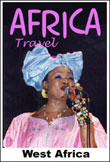Cote
d'Ivoire Advertising
Marcel
Amon Tanoh, Minister for Tourism visits
Sassandra Region (Cote
d'Ivoire) October 3, 2 003. As
usual all villagers, men, women, children,
elderly and young people were waking up
early in Trepoint Canton (east of the
sleepy and peaceful charming old colonial
town of Sassandra). However, this was not
an ordinary day: everybody was expecting
the arrival of the minister for Tourism
Marcel Amon Tanoh. That was a truly big
event. The one and only visit of a
minister for Tourism in the area took
place in April 2 000. As soon as he has
taken office, Marcel Amon Tanoh has
promised to come and visit the south-west
of Cote d'Ivoire with a view to listening
to and understanding people concerns,
reassuring potential tourists who may be
overly influenced by abusive advice
against visiting this peaceful and
friendly region and altogether boosting
tourism, reducing poverty and improving
people's well-being. While the Neyo
(originating from Liberia or the border
and living in the Trepoint region since
the XIII th Century) belong to the Krou
ethnic group and their language is close
to Bete with some English influence, their
traditions are similar to those of the
Akan group (living in the east and center
of Cote d'Ivoire). Each color or motif has
a different meaning. Some of them are
reserved exclusively for chiefs and
prestigious ceremonies. Most of them
convey power and wealth although nowadays
pure gold is no longer mandatory. Dancers
and musicians are there too and are
rehearsing. Chiefs are opening bandji
(palm wine) cans and start drinking. Women
shout and sing ; young boys dance, shout,
are tremendously exited and exceedingly
happy. Everybody has great fun.
Altogether, the scene is magnificent and
fascinating. To comport with tradition,
drums announce the arrival of the minister
immediately followed by the more modern
police horn. People yell, people bawl out,
people applaud, people sing, people greet
the group, people express their joy in any
possible way, drums are louder and
stronger as the minister and his spouse
immediately followed by Sassandra mayor,
priest and prefect step down from their
cars. Dances resume. Women who according
to Neyo tradition are only performing in
the most exclusive ceremonies and to the
sole benefit of a few dignitaries dance
gracefully. It's really amazing. The
minister, his spouse, the mayor and the
prefect are offered the best seats and a
glass of water. Everybody else take a seat
and watch the festivities going on.
Finally, silence is ordered, people are
calmed down and everybody listens
carefully to the villagers' spokesman
voicing out complaints and demands.
Tradition is now combined with modernity.
While the minister, his team leaders and
media are getting acquainted with Best of
Africa comfortable facilities and up to
date conveniences, by the beach ritual
songs and drums prolong their mysterious
sound. 5 representatives of Dagbego
village, the minister, his spouse,
top-rank officials, journalists all of
them head toward Best of Africa main
building and enjoy their meal composed of
prawns, fresh seafood and grouper, taro
leaves, home-made sherbets and exotic
fruit salad accompanied with French and
Italian wine and lived up by the most
delightful dance by a young and darling
small girl wearing superb ancestral beads.
It's time to leave.A Guere (people from
the west) dance performed by two young men
closes the ceremony as tradition
suggests.

Grand Tour Edition
Advertise
Now
Abidjan
Best
of Africa
Cuisine
Dream
Place
News
Update
Map
Sassandra
Tourism
Ministry![]()
African
Countries
index/map
African Cities
Abidjan
Agadir
Addis
Ababa
Cairo
Cape
Town,
Casablanca
Dar
es Salaam
Essaouira
Conakry
Douala
Fez
Lusaka
Marrakech
Meknès
Rabat
Timbuktu
Yaounde
Classiified
Send
Rates
.
 Courtesy
Beatrice Grandcolas, Best of
Africa
Courtesy
Beatrice Grandcolas, Best of
Africa
![]() Marcel
Amon Tanoh lived up to his word and to
everybody's expectations; he did come.
First, early September, top-rank officers
from the ministry and the Ivorian Office
for Tourism (OITH) came and made all
necessary arrangements: they discussed
menus, people to invite, presents to give,
etc. Later on, official letters were
dispatched. Chiefs, notables, persons of
note from far away, dancers, singers,
musicians were called upon for organizing
the visit and welcoming the minister for
Tourism Marcel Amon Tanoh. Eventually
Friday, October 3 came. The sun was barely
rising, the sky was low, but everybody
heart was full of warmth and joy. Long
forgotten trunks were opened. Jewels were
cleaned up, finest apparels pressed and
golden sandals polished. Chiefs are
attired first: Kente cloth (traditional
hand-made luxurious material), golden
hats, golden chains, golden dolls and
beautifully designed pieces of
jewelry.
Marcel
Amon Tanoh lived up to his word and to
everybody's expectations; he did come.
First, early September, top-rank officers
from the ministry and the Ivorian Office
for Tourism (OITH) came and made all
necessary arrangements: they discussed
menus, people to invite, presents to give,
etc. Later on, official letters were
dispatched. Chiefs, notables, persons of
note from far away, dancers, singers,
musicians were called upon for organizing
the visit and welcoming the minister for
Tourism Marcel Amon Tanoh. Eventually
Friday, October 3 came. The sun was barely
rising, the sky was low, but everybody
heart was full of warmth and joy. Long
forgotten trunks were opened. Jewels were
cleaned up, finest apparels pressed and
golden sandals polished. Chiefs are
attired first: Kente cloth (traditional
hand-made luxurious material), golden
hats, golden chains, golden dolls and
beautifully designed pieces of
jewelry.![]()
![]()